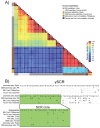Begomovirus-Associated Satellite DNA Diversity Captured Through Vector-Enabled Metagenomic (VEM) Surveys Using Whiteflies (Aleyrodidae)
- PMID: 26848679
- PMCID: PMC4776191
- DOI: 10.3390/v8020036
Begomovirus-Associated Satellite DNA Diversity Captured Through Vector-Enabled Metagenomic (VEM) Surveys Using Whiteflies (Aleyrodidae)
Abstract
Monopartite begomoviruses (Geminiviridae), which are whitefly-transmitted single-stranded DNA viruses known for causing devastating crop diseases, are often associated with satellite DNAs. Since begomovirus acquisition or exchange of satellite DNAs may lead to adaptation to new plant hosts and emergence of new disease complexes, it is important to investigate the diversity and distribution of these molecules. This study reports begomovirus-associated satellite DNAs identified during a vector-enabled metagenomic (VEM) survey of begomoviruses using whiteflies collected in various locations (California (USA), Guatemala, Israel, Puerto Rico, and Spain). Protein-encoding satellite DNAs, including alphasatellites and betasatellites, were identified in Israel, Puerto Rico, and Guatemala. Novel alphasatellites were detected in samples from Guatemala and Puerto Rico, resulting in the description of a phylogenetic clade (DNA-3-type alphasatellites) dominated by New World sequences. In addition, a diversity of small (~640-750 nucleotides) satellite DNAs similar to satellites associated with begomoviruses infecting Ipomoea spp. were detected in Puerto Rico and Spain. A third class of satellite molecules, named gammasatellites, is proposed to encompass the increasing number of reported small (<1 kilobase), non-coding begomovirus-associated satellite DNAs. This VEM-based survey indicates that, although recently recovered begomovirus genomes are variations of known genetic themes, satellite DNAs hold unexplored genetic diversity.
Keywords: Ipomoea satellites; alphasatellites; begomovirus; begomovirus-associated satellites; betasatellites; gammasatellites; metagenomics; ssDNA; vector; whitefly.
Figures



Similar articles
-
Vector-Enabled Metagenomic (VEM) Surveys Using Whiteflies (Aleyrodidae) Reveal Novel Begomovirus Species in the New and Old Worlds.Viruses. 2015 Oct 26;7(10):5553-70. doi: 10.3390/v7102895. Viruses. 2015. PMID: 26516898 Free PMC article.
-
Advances in understanding begomovirus satellites.Annu Rev Phytopathol. 2013;51:357-81. doi: 10.1146/annurev-phyto-082712-102234. Annu Rev Phytopathol. 2013. PMID: 23915133 Review.
-
A novel class of DNA satellites associated with New World begomoviruses.Virology. 2012 Apr 25;426(1):1-6. doi: 10.1016/j.virol.2012.01.024. Epub 2012 Feb 11. Virology. 2012. PMID: 22330203
-
Molecular diversity, recombination and population structure of alphasatellites associated with begomovirus disease complexes.Infect Genet Evol. 2017 Apr;49:39-47. doi: 10.1016/j.meegid.2017.01.001. Epub 2017 Jan 4. Infect Genet Evol. 2017. PMID: 28062387
-
Journey of begomovirus betasatellite molecules: from satellites to indispensable partners.Virus Genes. 2020 Feb;56(1):16-26. doi: 10.1007/s11262-019-01716-5. Epub 2019 Nov 27. Virus Genes. 2020. PMID: 31773493 Review.
Cited by
-
Characterisation of the Viral Community Associated with the Alfalfa Weevil (Hypera postica) and Its Host Plant, Alfalfa (Medicago sativa).Viruses. 2021 Apr 28;13(5):791. doi: 10.3390/v13050791. Viruses. 2021. PMID: 33925168 Free PMC article.
-
Genome Sequences of Beet curly top Iran virus, Oat dwarf virus, Turnip curly top virus, and Wheat dwarf virus Identified in Leafhoppers.Genome Announc. 2017 Feb 23;5(8):e01674-16. doi: 10.1128/genomeA.01674-16. Genome Announc. 2017. PMID: 28232449 Free PMC article.
-
Virus discovery in all three major lineages of terrestrial arthropods highlights the diversity of single-stranded DNA viruses associated with invertebrates.PeerJ. 2018 Oct 11;6:e5761. doi: 10.7717/peerj.5761. eCollection 2018. PeerJ. 2018. PMID: 30324030 Free PMC article.
-
Geminivirus data warehouse: a database enriched with machine learning approaches.BMC Bioinformatics. 2017 May 5;18(1):240. doi: 10.1186/s12859-017-1646-4. BMC Bioinformatics. 2017. PMID: 28476106 Free PMC article.
-
The Role of Satellites in the Evolution of Begomoviruses.Viruses. 2024 Jun 17;16(6):970. doi: 10.3390/v16060970. Viruses. 2024. PMID: 38932261 Free PMC article. Review.
References
-
- Leke W., Mignouna D., Brown J., Kvarnheden A. Begomovirus disease complex: Emerging threat to vegetable production systems of West and Central Africa. Agric. Food Secur. 2015;4 doi: 10.1186/s40066-014-0020-2. - DOI
-
- Ha C., Coombs S., Revill P., Harding R., Vu M., Dale J. Molecular characterization of begomoviruses and DNA satellites from Vietnam: Additional evidence that the New World geminiviruses were present in the Old World prior to continental separation. J. Gen. Virol. 2008;89:312–326. doi: 10.1099/vir.0.83236-0. - DOI - PubMed
Publication types
MeSH terms
Substances
LinkOut - more resources
Full Text Sources
Other Literature Sources
Miscellaneous

